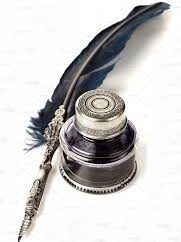
Rembrandt and the Robin in the Age of Aquarius
I am uncertain whether I’ll be able to ‘pull this off’, as they say, or are the two I have in mind just too disparate? Yet, after all . . . So, here it goes: There is a self-portait by Rembrandt from when he was old, and he looks at me, across the time of some 400 years . . . Behind him, on the wall, are two, yes, disparate segments of a circle, somewhat back to back, those two halves; the general understanding as to what they might mean, is a reference to the painter Giotto, some 400 years before: when asked to prove his artistic skill, he complied by drawing a perfect circle with a single fluent movement. There it is: the anecdote speaks of a single circle, yet in Rembrandts painting there are two parts of it, disparate – or . . . ? There is a certain place by the River Thames, not exactly a peninsula, but somewhat rounded by the vegetation growing on the shore – the river’s just beyond. Brambles, trees and bushes almost form a rounded alcove. This is where I and my Beloved enjoy to sit. And each time we go there a tiny robin comes to be with us – well, I guess, were sitting in his parlour . . . We feed him crumbs from our biscuits, having learnt that he likes them really, really small. But that’s not all: he looks at us, seems to be speaking eye-to-eye, and, to see us even better, he leaps about, then flies all around us, yes! in a circle which he completes in a single, fluent movement! And not just once, again, and yet again. No longer do we need to ask, ‘Will the circle be unbroken?’ As this, at last, finally, is the Age of Aquarius – since the last Winter Solstice, merely weeks ago! We are the ones we have been waiting for! And we are one, the two halves have been joined, the circle is complete in a single, fluent movement – not just the two of us, but you, and you, and you – you, too! And you! – We. Are. So. Many! Gottfried Maria Heuer, London, January/February 2021
The Gathering of the Rebel Angels
Otto Gross – 1977 – 1920 – was the first psychoanalyst to link analysis with revolutionary change, for which, at the time, he was made an outcast of the psychoanalytic endeavour. Yet he had a strong influence on both Freud, Jung, and many others. They ‘stole from him to adorn their own posteriors’ (Kuh, 1920): ‘A hundred years ago, he wrote the theory for the therapy of tomorrow’ (Madison, 2001). Gross’ colleagues exercised on him what the ancient Romans called damnatio memoriae – the damnation of memory: they tried to erase him from history. For some 25 years, I have helped to correct this with my research, in the course of which I founded the International Otto Gross Society (for which I [co-]edited some 5000 pages of congress proceedings), now the International Association for Gross Studies. My book is, Freud’s ‘Outstanding’ Colleague/Jung’s ‘Twin Brother’. The Suppressed Psychoanalytic and Political Significance of Otto Gross’ (London & New York: Routledge, 2017). – After congresses all over central Europe, the 10th one was in Moscow in 2017 – the 100th anniversary of the Russian Revolution. Gross, I imagine, would have enjoyed that – he died before everything in Russia went pear-shaped and worse . . .
I’ll start with some words that are not mine but come from ‘A Course in Miracles’:
‘It is a little while
till timelessness
comes quietly
to take the place of time.’
And now to my poem:








Dr. Gottfried M. Heuer, Jungian Training-psychoanalyst and -supervisor, Neo-Reichian body-psychotherapist and –trainer; some 40 years of clinical practice in London – including work in many European countries, including Russia, North, Central and South America, Africa and Australia; independent scholar with some 70 papers published in 7 languages. His books include 10 Otto Gross Congress–proceedings (LiteraturWissenschaft.de); Sacral Revolution (Routledge 2010); Sexual Revolutions: Psychoanalysis, History and the Father (Routledge 2011; Russian edition 2017); and Freud’s ‘Outstanding’ Colleague/Jung’s ‘Twin Brother’: The Suppressed Psychoanalytic and Political Significance of Otto Gross (Routledge 2017); and he is also a published graphic artist, photographer, sculptor and poet. Interviews @ https://vimeo.com/196609212 and https://youtu.be/zxEkj9SsAKw
